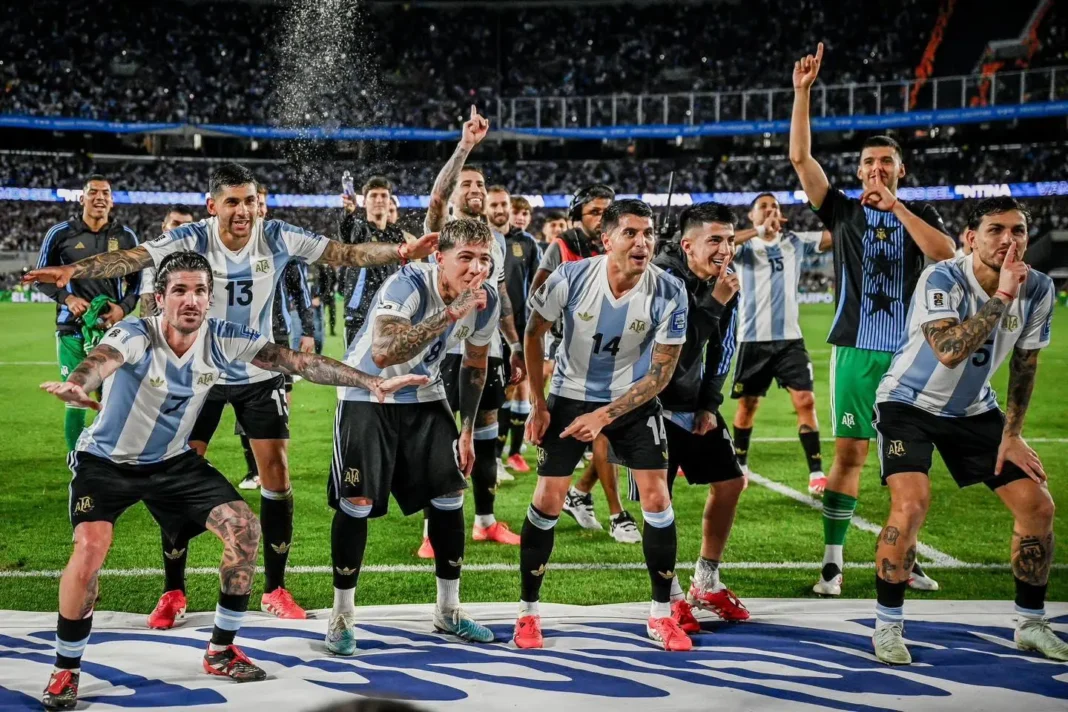The man, the myth, and the shrewd innovator Lionel Scaloni took charge of Argentina in August 2018 when everything for the nation was in a swamp. Argentina was a fallen giant — disunited, directionless, and emotionally drained. Six years later, he turned them into the most balanced, cohesive, and mentally strong team in world football. His team won the Copa America twice, in 2021 and 2024, thereby conquering South America on two occasions. He also won the most coveted prize, this beautiful game has to offer, i.e. World Cup in 2022. He also won the Finalissima against Italy.
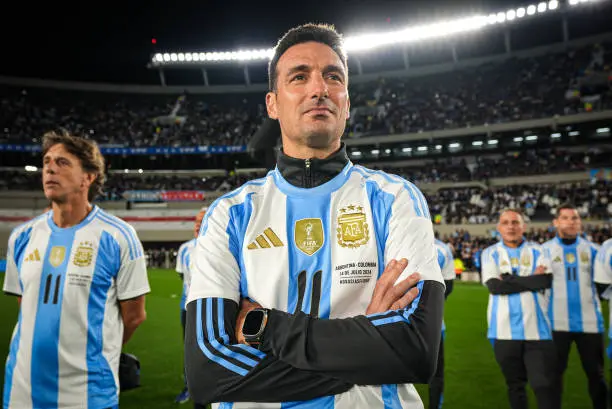
With many young guns emerging from Europe’s Top 5 leagues, and with the vision of the veterans of the team, including Messi, Lautaro Martinez, Dibu Martinez, etc, Argentina looks to glorify their history and emerge as a successful defending champion in 2026.
POSSIBLE SQUAD
- While Argentina will surely miss one of their clutch players who has always stood out in finals for Argentina, Angel Di Maria, many young talents, especially in the attacking front, have emerged for the nation who will try to fill Di Maria’s boots.
- In Goal, Argentina has the experience of Emi Martinez, who has built his reputation over the past years in the critical and match-deciding moments.
- In defence, Argentina relies on previous World Cup winners like Cristian Romero, Otamendi, Molina, Acuna, and Montiel. With Tagliafico also fit to play this campaign, the defence looks rock solid.
- Midfield controls the tempo of the game and plays as a link between attack and defence. With a good mixture of both attacking midfielders (Enzo Fernandez, Claudio Echeverri, Franco Mastanuono) and defensive midfielders (Alexis Mac Alister, Rodrigo De Paul, Leandro Paredes), Argentina can adapt pretty quickly according to the requirement.
- Whilst uncertainty surrounds Messi’s possibility of playing the World Cup, his teammates are quite certain, they will convince Messi to play. And with his genius and presence on the pitch, Argentina’s attackers and forwards can quickly pounce on the passes delivered by Messi and the midfielders. Players like Alejandro Garnacho and Nico Gonzalez can prove to be X factors. Argentina might have two of the most consistent attackers in world football, who have proved their mettle at both club and International level, that is Lautaro Martinez and Julian Alvarez.
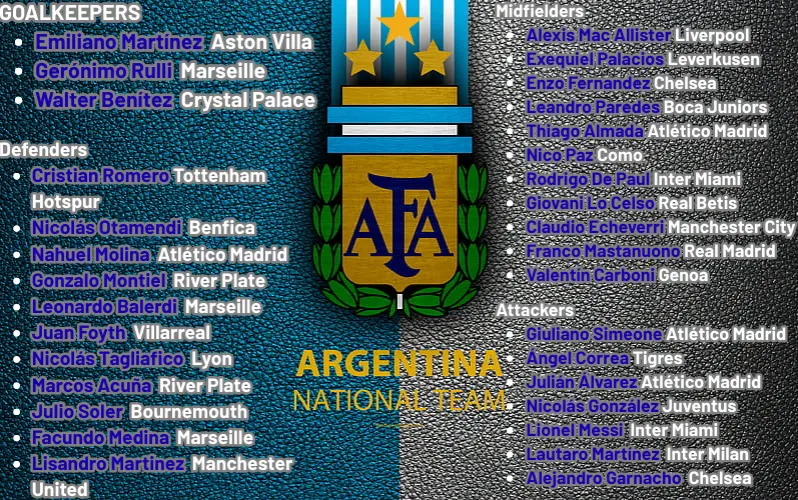
PREDICTED PLAYING XI
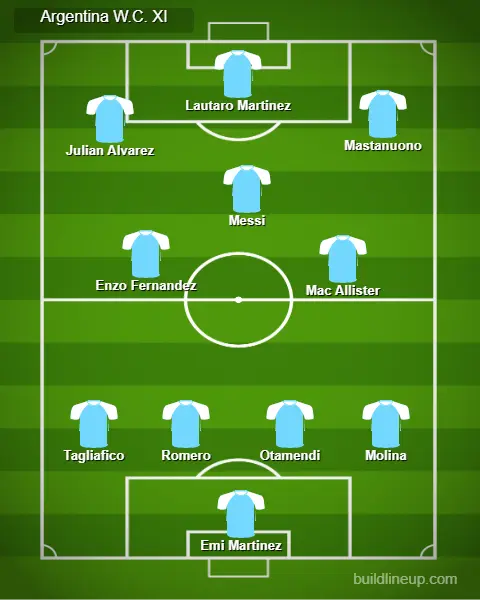
ROAD TO QUALIFICATION
- Scaloni made sure that Argentina continued their rich vein of form after conquering the 2022 World Cup. Argentina began their CONMEBOL World Cup qualifying campaign in September 2023 as reigning world champions — and they’ve played like it.
- They successfully defended the Copa America trophy too in 2024.
- Argentina has played 18 matches in the CONMEBOL 2026 World Cup qualifiers. They have won 12, lost 4, and drawn 2 matches. They comfortably sit on the top with a massive 9 points margin over 2nd-placed Ecuador, reflecting not just results, but maturity and tactical discipline. Their qualification path has been less about proving themselves — and more about maintaining the elite standard they set in 2022.
POSSIBLE FORMATIONS
While Scaloni used a 4-3-3 formation mainly in the World Cup 2022 Campaign, he used to change formation mid-game for better adaptability. This campaign, he has used a 4-3-3 formation mainly, but he has used different formations in various games depending on which type of player profiles were available.
- 4–3–3 (incl. “4-3-3 — Attacking” label)— 8 matches.
Transfermarkt labels this as Argentina’s primary system in many fixtures; it’s the standard shape used to give Messi and the front three freedom while keeping a three-man midfield pivot. - 4–4–2 (and close variants)— 5 matches (this total includes straight 4–4–2 and the more structured 4–4–2 diamond listed separately on some match pages).
Used especially when Scaloni wanted more defensive solidity or to field two strikers/pressers up front (common in more physical away fixtures). - 3–5–2 (flat / wing-back)— 2 matches.
Employed when Scaloni wanted extra midfield control or overloads on the wings (Transfermarkt tags include “3-5-2 flat” for specific matches). - 4–2–3–1— 1 match.
Used as a tweak to give Messi more support from a No.10 and two holding midfielders in front of the back four. - 4-2-2-2 —1 match.
He uses this when he wants central overloads instead of wide play. It lets players like Messi and Álvarez stay close together, while De Paul and Enzo Fernández form the deeper pivot. The width then comes from full-backs (Molina and Tagliafico).
STRENGTHS
- The squad has remarkable chemistry, built over the years under Lionel Scaloni.
- The core group from 2022— Messi, De Paul, Martínez, Otamendi, Molina, Enzo Fernández, and Álvarez — remains intact, providing familiarity and tactical stability.
- Scaloni’s man-management keeps egos low and unity high.
- Emiliano Martínezis among the most reliable goalkeepers in world football. He successfully led Argentina to victories in major penalty shootouts with his intriguing character that instills fear in the minds of attackers
- The Romero–Otamendi partnership brings aggression and leadership.
- Full-backs like Molina and Tagliafico balance defense and attack well, ensuring compactness.
- Lautaro Martinez has been one of the most consistent forwards both for his club and the nation. He has been included in the top 30 Ballon d’Or many times. He has also reached UEFA Champions League finals twice with his club
- “La Araña”, Julian Alvarez, who was one of the most expensive buys of last summer window, has shown his dominance with Manchester City and now Atletico Madrid. From taking free kicks, to corners, to penalties, and shooting from long range, he is almost a complete package for Argentina.
WEAKNESS
- Limited Width – Without traditional wingers, Argentina’s width often depends on overlapping full-backs, which can leave space behind. Against teams with fast counterattacks, this can be a vulnerability.
- Dependency on Messi – Despite evolution, Argentina still relies heavily on Messi’s playmaking in tight matches. When he’s absent or heavily marked, they occasionally struggle to unlock low-block defenses.
- Fewer goals from Midfield – The midfield trio focuses more on control and pressing than goal-scoring. Out of 31 total goals, 8 have come from midfielders, which is roughly ~26%of Argentina’s goals in the campaign.
X-FACTORS
- Alejandro Garnacho (Chelsea)– He is a direct, fearless dribbler who can break defensive lines — something Argentina occasionally lacks when Messi drops deep.
- Lautaro Blanco (Elche / Olympique Marseille) – He makes energetic overlapping runs with precise crossing. He provides attacking width that complements Argentina’s narrow shape. He is useful when Tagliafico or Acuña are unavailable; high work rate and balance between defense and attack.
- Lisandro Martínez (Manchester United) – Not just a defender — he starts play from the back with laser-sharp diagonals and aggression.
- Exequiel Palacios (Bayer Leverkusen) – A reliable game-controller off the bench — keeps intensity high when De Paul or Enzo rest.
CONCLUSION
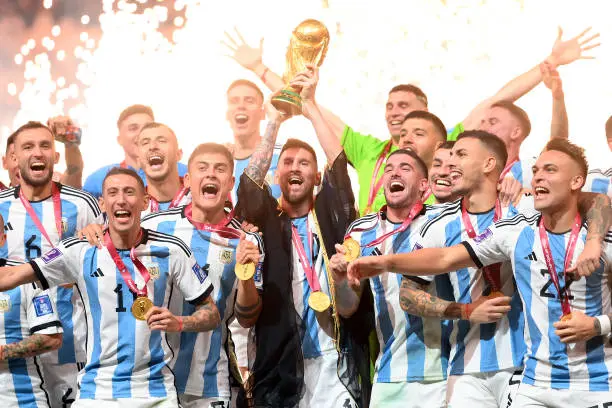
While Messi has already etched his name in the history books, fulfilling his long-awaited dream to again put Argentina on the big stage after the great Diego Maradona did in 1986, he will again try to achieve Nirvana, to reach the peak of paradise with a consecutive World Cup. With Scaloni’s tactical genius and the young blood of Argentina, along with the experience of the Veterans, the dream is pretty much in the basket with both hands to grab and put the privileged and esteemed “Cuatra Estrella” on the National jersey.

